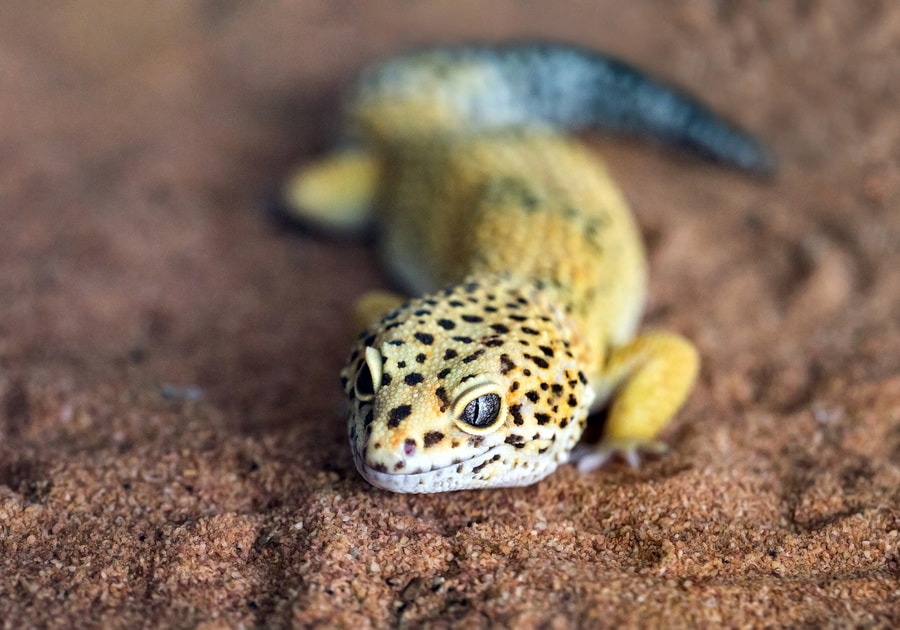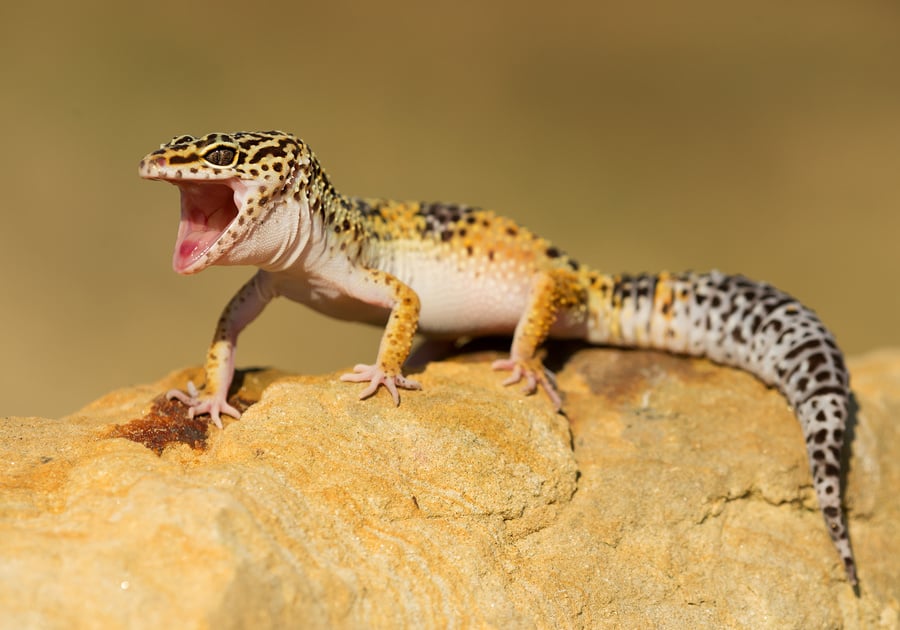
Leopard Geckos are ground-dwelling lizards that are commonly known as pets to several individuals. These reptiles’ natural habitat is typically the dry grassland and desert areas of India, Nepal, and other countries. Due to their innate behaviors, they are fascinating animals to have around.
Leopard geckos are intelligent reptiles, but they don’t exhibit extreme levels of intelligence. These reptiles know when to hide, get aggressive, or stay sedentary. The smartness of leopard geckos is incomparable to that of other pets, but they recognize their names and owners in most cases.
Reptiles like leopard geckos may not be as intelligent as dogs and some other mammals, but they have fundamental intelligent characteristics. An example that shows how smart they are in their defense mechanism. Leopard geckos escape from threats of major predators due to their unique sense of sight and hearing.
Undoubtedly, most of the characteristics of leopard geckos are innate, especially their ability to escape from danger. These reptiles can camouflage themselves from predators like foxes, snakes, or giant reptiles. During the daytime, the geckos exhibit a significant intelligence level by burrowing holes to avoid predators and staying away from heat.
As a survival instinct or minor sign of smartness, leopard geckos also shed their skins to avoid tracking or detection. In times of attack, the common leopard geckos can also willfully detach their tails. In such moments, the detached tail may twitch for several minutes, which also helps the gecko escape danger.
Like most pets, leopard geckos can recognize your voice, but it takes a significant level of consistency. It may be essential to constantly move to your gecko’s terrarium daily to create a level of familiarity between you and the reptile.
How Smart Are They?
Leopard geckos have unique sets of characters that allow them to survive and stay protected from significant predators. These lizards can also bond with the owner, and they typically recognize their name when you call. Leopard geckos also exhibit territoriality and other features at the appropriate period.
Leopard geckos can determine the sex of their fellow species by smelling pheromones on their body. Note that pheromones are chemicals that some animals produce to affect other animals’ behavior of the same species. Note that leopard geckos can sense the sex pheromones, which is different from the food trail pheromones.
When male leopard geckos sense a need to exhibit territoriality, they typically display aggression towards other male species. On the other hand, these males are smart enough to display females’ courtship behavior instead of males’ immediate aggression.
As an owner, you should observe that your leopard gecko shows its smartness level in different ways. These reptiles may give up chasing a specific prey if it’s a couple of millimeters away from sight. Leopard geckos may hide in some areas of their vivarium also due to fear of some objects.
Your leopard gecko can’t shed its skin at the appropriate time to avoid tracking. These animals also have incredible eye sights to see various objects and colors, even at night. The reptiles don’t need the same degree of ultraviolet light-B as some other similar species.
Note that the UVB light for reptiles like the leopard geckos is not essential, but certain herpetologists recommend using them. Note that the use of a UVB light doesn’t directly influence the gecko’s smartness, but it plays a role in its overall behavior.
Do Leopard Geckos React on Instincts or Logic?
Leopard geckos don’t react to logic, but they take most actions based on their instincts. Some of the common reactions of leopard geckos, depending on the specific event, include charging with an open mouth. These reptiles may also hiss or scream when something occurs.
Leopard geckos are generally very territorial and don’t like similar species in their habitat. For this reason, you may often observe that they react by getting engaged in a fight. It’s inaccurate to state that leopard geckos act based on logic because they often get aggressive for seemingly controllable situations.
Most leopard geckos fight each other by biting their tails and reaching out to throw slaps. For this reason, most experts advise that two leopard geckos shouldn’t be in the same region.
Other signs of instincts over the logic that you may observe in leopard geckos is their response to threat during the night. These pets can be smart enough to camouflage themselves against potential predators. Due to the need for them to stay safe, they conventionally burrow during the day and stay inside underground holes.
Generally, the sense of smell of leopard geckos plays an essential role in their survival. Many individuals may also observe that these geckos take instinctive steps like detaching on their tales due to attacks or getting bitten during copulation.
Ensure that you don’t overlook the absence of a tail on your gecko. When you observe that your reptile pet doesn’t have its tail in place, seek help from a licensed veterinarian. The absence of a tail leads to a high level of stress on the pet due to fat loss.
Are Some Smarter than Others?
No, leopard geckos don’t have different levels of smartness. These reptiles have natural characteristics that may not classify as intelligent. All geckos can see in the dark and hear appropriately, especially when in times of danger.
Generally, many scientists state that reptiles have a significant level of smartness. However, there isn’t enough research around the smartness of common lizard geckos. Other reptiles like the monitor lizard, the emerald anole, the king cobra, and the snapping turtle are the well-known smart ones.
The snapping turtle, as an example, has prolonged movements, and they learn to know their food containers and the sound of food around them. These animals typically try to climb rocks and burrow through the mud to escape their outdoor ponds.
Apart from the snapping turtle, the monitor lizard is a significant example of an intelligent reptile. Monitor lizards are well-known for counting snails at feeding times and displaying unique personality traits. Note that both the snapping turtle and monitor lizard are a little smarter than the common leopard gecko.
The leopard geckos’ owners conventionally report that these animals sometimes climb trees in their vivarium, even when they don’t expect them to take action.
Without a doubt, reptiles like leopard geckos are impressively intelligent. However, it’s impossible to compare their intelligence level to that of humans or many other mammals. It’s safe to say that geckos operate more based on their inbuilt capabilities than any unique level of smartness.

Do Leopard Geckos Think & Reason?
No, leopard geckos don’t think and reason but, they can perform fundamental tasks for survival. These reptiles know when it’s time for reproductive acts, and they also protect their territories from other similar leopard geckos when they feel threatened.
Thinking is an activity that you should only associate with humans and a few brilliant animals like dogs. It involves using the brain by considering a problem or possibility. Similar to thinking, reasoning is also an action that involves analyzing something logically.
Generally, science continues to discover that animals, including reptiles, can think to a certain extent. For example, newborn chickens can calculate, parrots can talk, and chimpanzees can help each other.
If you need a pet with the ability to think and reason, a leopard gecko is not the best option for you. Note that even though the leopard geckos are incapable of thinking, they still have a strong ability to know when to take action, especially when they are frightened.
A proof that reptiles like the monitor lizard can think of is the study at San Diego Zoo. The research involved Savannah Monitors. Impressively, the conclusion of the study pointed to the ability of those reptiles to count.
In the study, researchers fed the lizards with snails. Note that those monitor lizards were previously conditioned to expect several snails in their chambers. If the lizards expect four snails and only get three, they would search for the last one even when they get another round of four snails.
Do They Recognize Their Owners & Names?
Yes, leopard geckos recognize their owners and names. These reptiles can know their owners by their scents, and they can also know by their tone of voice. Leopard geckos can also learn to get comfortable around their owners with time.
Leopard geckos and other similar reptiles typically get very attached to their owners by forming bonds between them due to the owner’s handling method. As an owner, you should ensure that you take them out for enrichment activities outside the cages’ confinement.
Since leopard geckos majorly get attracted to the scent of owners, there’s a high tendency that your pet may change its behavior when there’s a change in your smell. If you have issues making your leopard gecko attached to you, start by making it gain your trust.
A significant example of making your leopard gecko attached to you is by making identifiable sounds often. When your gecko observes your consistent sound and presence, you can ultimately earn its trust. It’s also essential to note that your leopard gecko’s enclosure plays a critical role in the degree of trust between you and the pet.
The most advisable way to handle your leopard gecko is by washing your hands with a non-scented soap. By doing this, you are avoiding getting attacked by the leopard geckos. Due to the aggressive nature of leopard geckos, it’s essential to ensure that you’re not taking any actions that affect their trust and make them aggressive.
Will They Adopt Learned Behaviors?
No, there’s no scientific research or proof that shows leopard geckos can adopt learned behaviors. Most of the actions or behaviors of leopard geckos are instinctive, and they aren’t directly related to any specific learned behavior.
Common behaviors of leopard geckos as pets include climbing their tanks, hiding, squealing or yelping, tail biting, tongue flicking, and tail wiggling. Generally, climbing the tank is a normal behavior of leopard geckos. It could be due to their environment, especially when it’s uncomfortable.
If you observe that your leopard gecko is hiding, you should note that it’s due to its nature. However, there may be a temperature issue if your gecko is hiding for over 24 hours.
The squealing or yelping sounds only occur when they are startled or surprised. The reptiles typically prolong those sounds for some time until they can escape the situation. Note that the squealing or yelping sounds are prevalent in the younger leopard geckos compared to the older ones.
As an owner of two or more leopard geckos, you may have observed tail biting, especially when they are both in the same vivarium. Actions like tongue flicking allow them to sense objects and their overall environment. Lastly, “tail waggling” can be slow, fast, defensive, or excited, each representing unique moods.
The slow tail shakes signify acknowledging other leopard geckos; the fast tail shakes are typically by the male geckos to indicate that they are with female leopard geckos.
The defensive tail shakes occur when they are threatened. In most cases, the gecko will lower its body to the ground and have its head arched up. Note that the “excitement shakes” occurs when the leopard gecko hunts for bugs.
Do They Have Feelings?
No, leopard geckos don’t have feelings. Owners may assume that most of their actions are based on feelings, especially when they are aggressive. Unfortunately, these reptiles act on their instincts instead of any feelings.
Leopard geckos and many other reptiles have actions that you may think are feelings, but they are based on their instincts. Fortunately, the fact that leopard geckos don’t have feelings doesn’t mean that they wouldn’t react appropriately to your touch.
If your scent doesn’t smell like a danger to them, they shouldn’t have any issues with you getting close. Apart from your scent, you should ensure that you take actions that don’t appear as red flags. For example, avoid interrupting their sleep and playing loud music. Also, ensure that you are very careful when you hold them and fulfill their needs.
As an owner looking forward to a great relationship with his or her leopard gecko, ensure that you love these reptiles. Leopard geckos are fantastic creatures, so it’s essential to treat them right even if they cannot show emotions.
One of the essential factors that you should get right as an owner is their feeding. Ensure that your geckos eat a diet of invertebrates, including calci worms, waxworms, small locusts, and crickets.
For better care, ensure that the vivarium is the perfect choice for your leopard gecko. For an adult gecko, ensure that the tank has a minimum length of 60cm, a height of 40cm, and a depth of 30cm. For bacteria prevention, the setup should also be straightforward to clean.
Conclusion
Leopard geckos are amazing reptiles, but they aren’t as intelligent as other reptiles like monitor lizards or turtles. However, you shouldn’t have a problem with them once you follow the necessary steps for adequate care.
One of the essential rules to follow is that you shouldn’t house two leopard geckos together, especially male adults. As an owner, you should also be very careful about your scents because they are sensitive to the smell of objects and the environment.
